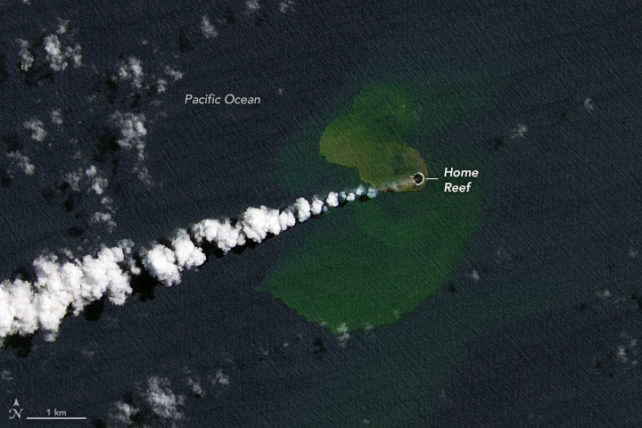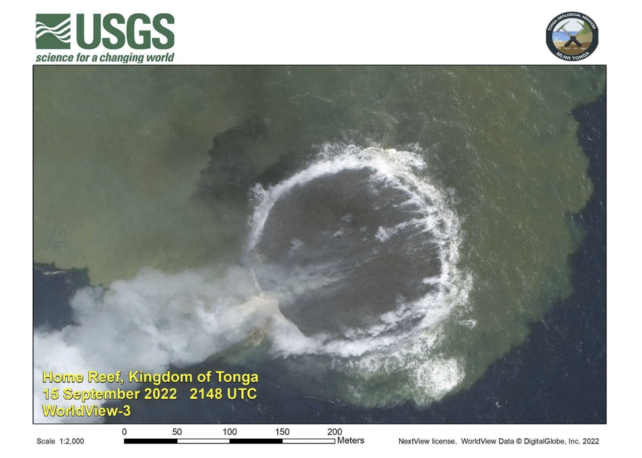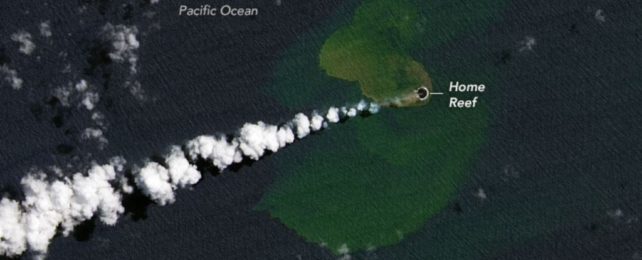A submerged volcano on the seamount known as the Home Reef in the central Tonga Islands has awoken after 16 years of deep sleep to poke its head out of the blue.
On 10 September 2022, lava and rock fragments began to ooze into the ocean 25 kilometers (15 miles) southwest of Late Island, while plumes of steam and ash burst through the surface of the waves.
Slowly the debris gathered into a whole new island, covering 4,000 square meters (one acre) and reaching a height of 10 meters (33 feet) within a few days.
Though it would barely grow much taller, on September 20, officials from the Tonga Geological Services (TGS) announced that the island had swelled six times in size, expanding to 24,000 square meters.
Like a phoenix rising from the ashes, this ephemeral, unnamed structure will probably sink back down into the Pacific Ocean's burning 'Ring of Fire' long before any seafarer might hope to set foot on its rocky shore.
The last time Home Reef gave birth to a new island, in 2006, it took a year for the ocean's waves to erode its crest. This time, the crest is much shorter.
So much debris was produced by the submerged Tonga volcano in the 2006 event, an expansive raft of the frothy volcanic glass known as pumice was set adrift across the South Pacific, giving the eery appearance of land.
You can see footage of that raft below:
Since 1852, Home Reef has produced islands on five occasions, some reaching between 50 and 70 meters in height. In 1984, the island even bore a small lagoon.
The seamount responsible for these short-lived structures sits in a region of the Pacific Ocean known as the Tonga-Kermadec subduction zone, which holds some of the fastest converging tectonic plates in the world.
Here, the Pacific Plate is rapidly slipping under two other plates (the Kermadec and Tonga) at a rate of about 24 centimeters a year (9 inches), forming the second deepest trench in the world and an extremely active volcanic arc.
In fact, this long stretch of seafloor ridge, which spreads from Tonga to New Zealand, is home to the highest density of underwater volcanos found anywhere on Earth.
Satellite images of the Home Reef's recent eruption capture the formation of its newest island in stunning detail. The image below was released by NASA using US Geological Survey data on September 14.
It shows not only a long trail of smoke but an intense discoloration of the surrounding ocean.

A follow-up image taken on September 18 using USGS data and shared by the TGS on Facebook zooms in on the volcanic fall-out, as can be seen below.

The clouding of the water is probably a result of superheated acidic seawater, mixed with chunks of volcanic rock and debris, according to a recent press release from NASA.
"The volcano poses low risks to the aviation community and the residents of Vava'u and Ha'apai," TGS announced on September 20.
"All mariners are, however, advised to sail beyond 4 kilometers away from Home Reef until further notice."
Since September 25, there have been no more sightings of volcanic ash or steam from this slice of the Pacific. Home Reef is probably done for now, leaving us to appreciate its latest gift to the sea while we can.
